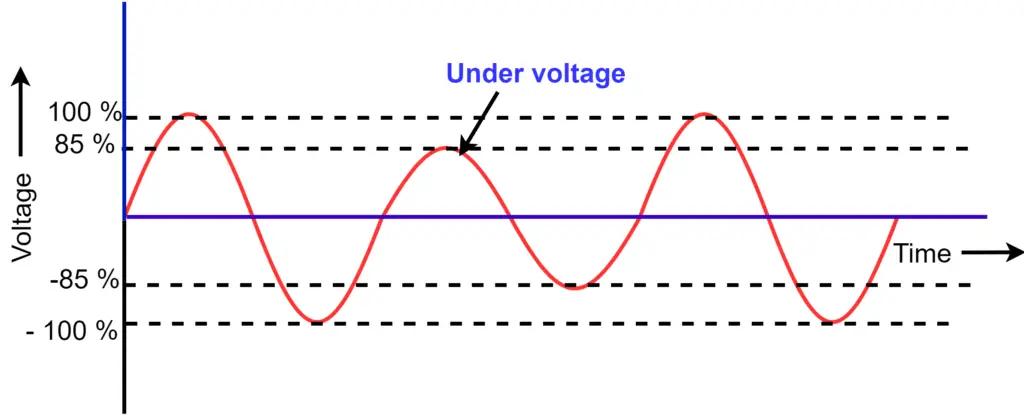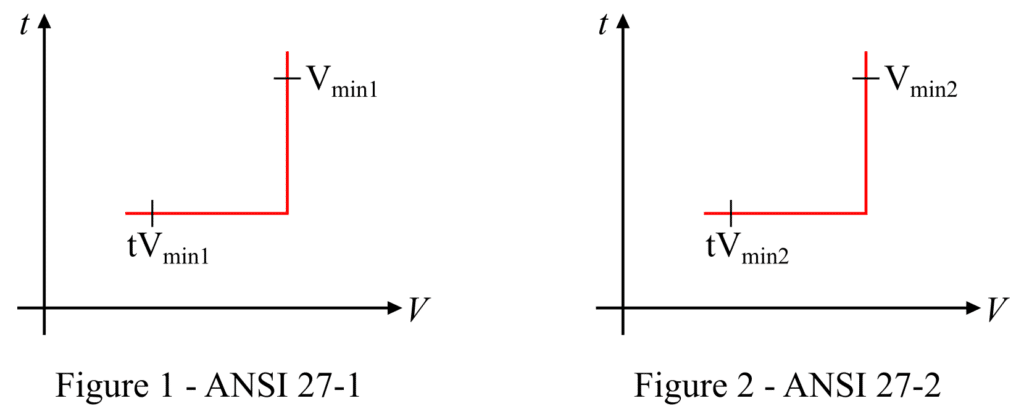In this article, we will discuss the working principle and configuration of the under voltage (ANSI 27) protection relay.
In under-voltage conditions, the system voltage falls below a certain level.

What is the Under Voltage Protection System?
Under voltage is a fault condition in the power system which damage the system equipment such as alternators, generators, transformers, etc. Thus, the protection system employed for protecting the power system equipment from low voltage operation is referred to as under voltage protection.
The under-voltage condition in the system is determined using an instrument transformer (potential transformer). This potential transformer senses the phase-to-phase voltage of the alternator or transformer, and if this voltage drops below the rated voltage, typically 90% for stage-1 and 85% for stage-2, then the under voltage protection system is activated. In this case, the under voltage protection relays give a trip indication.
Reasons of Under Voltage
The main reasons for the occurrence of the under voltage in the power system are as follows-
- Under voltage may occur due to any electrical fault in the system.
- Under voltage may occur due to an increase in the load on the system.
- Under voltage may occur due to the loss of an incoming transformer.
- Under voltage may also occur due to failure of transformer earthing and overloading of the transformer.
Under normal operating conditions, the system voltage is adjusted within the standard voltage limits by the transformer on-load tap changers and automatic voltage regulators (AVRs) of alternators.
In actual practice, the value of under voltage is set to 85% of the normal operating voltage. If the operating voltage goes below this level for a relay setting time, then the relay issues a trip command to break the circuit. The time setting of the relay is used to avoid tripping due to transients.
About the Under Voltage Protection ANSI 27
The under voltage protection 27 system constantly monitors the system voltage. If the system voltage falls below an acceptable limit, then the information provided by the under voltage protection is used to take appropriate action so that the system can be restored to good operating conditions.
The settings of the under voltage protection are used to generate an alarm and trip the circuit breaker when required. The under voltage protection 27 requires an external power supply of 24 V DC.
Operating Principle of Under Voltage Protection 27
Under voltage protection 27 monitors either phase-to-phase voltages (VRY, VYB, VBR), or phase-to-neutral voltages (VRN, VYN, VBN).
Under voltage protection 27 is of the following two types-
- ANSI 27-1 – In this system, each voltage is monitored independently. The protection initiates when one of three monitored voltages falls below the threshold Vmin1, as shown in figure-1.
- ANSI 27-2 – In this protection, the three voltages are monitored together. The protection initiates when all three monitored voltages fall below the threshold Vmin2 as shown in figure-2.

Each type of under voltage protection, i.e. ANSI 27-1 and ANSI 27-2 can be disabled, and these both types of under voltage protection operate according to a settable time delay as-
- ANSI 27-1 – The time delay tVmin1 starts as soon as the protection initiates as shown in figure-1.
- ANSI 27-2 – The time delay tVmin2 starts as soon as the protection initiates as shown in figure-2.
Under Voltage Relay Settings
The following settings are to be done in the under voltage protection 27 relay.
- Stage 1 – If the operating voltage reaches 90% of the rated voltage, then issue a trip command to the grid circuit breaker.
- Stage 2 – If the operating voltage reaches 85% of the rated voltage, then issue a trip command to the generator circuit breaker.
Characteristics of Under Voltage Protection
The following are the characteristics of under voltage protection-
- It has a definite time delay.
- Under voltage protection has an instantaneous reset time.
- It has fixed 98% hysteresis.
- It has a minimum breaking time of 50 ms.
- It has a maximum breaking time of 140 ms (with a time delay of 0 sec).
Important – Sometimes, the under voltage may also be due to excitation failure of the alternator, if so then check and rectify the generator excitation system.
well explained and continue with such articles .there very helpfull to electrical beginners.